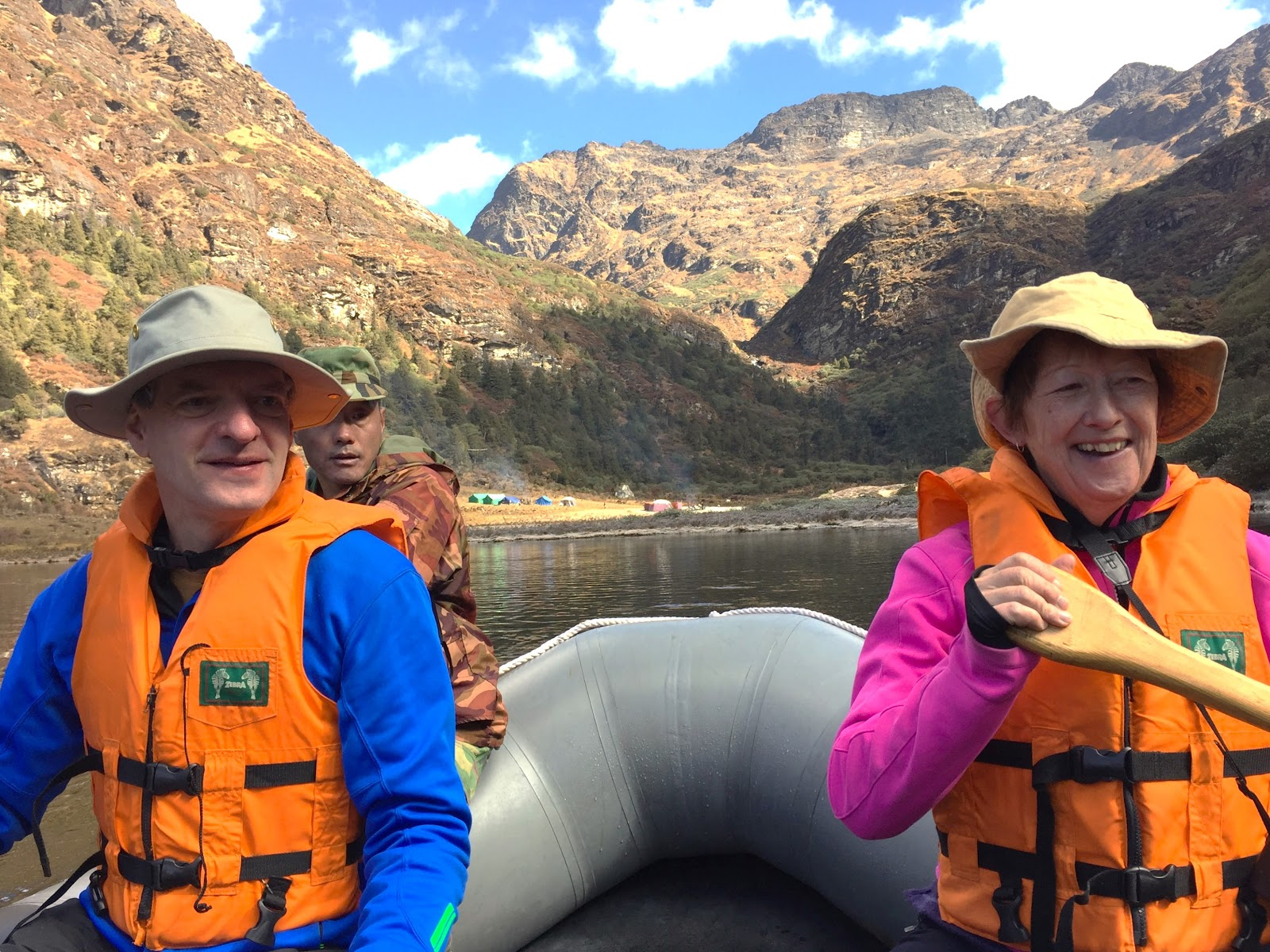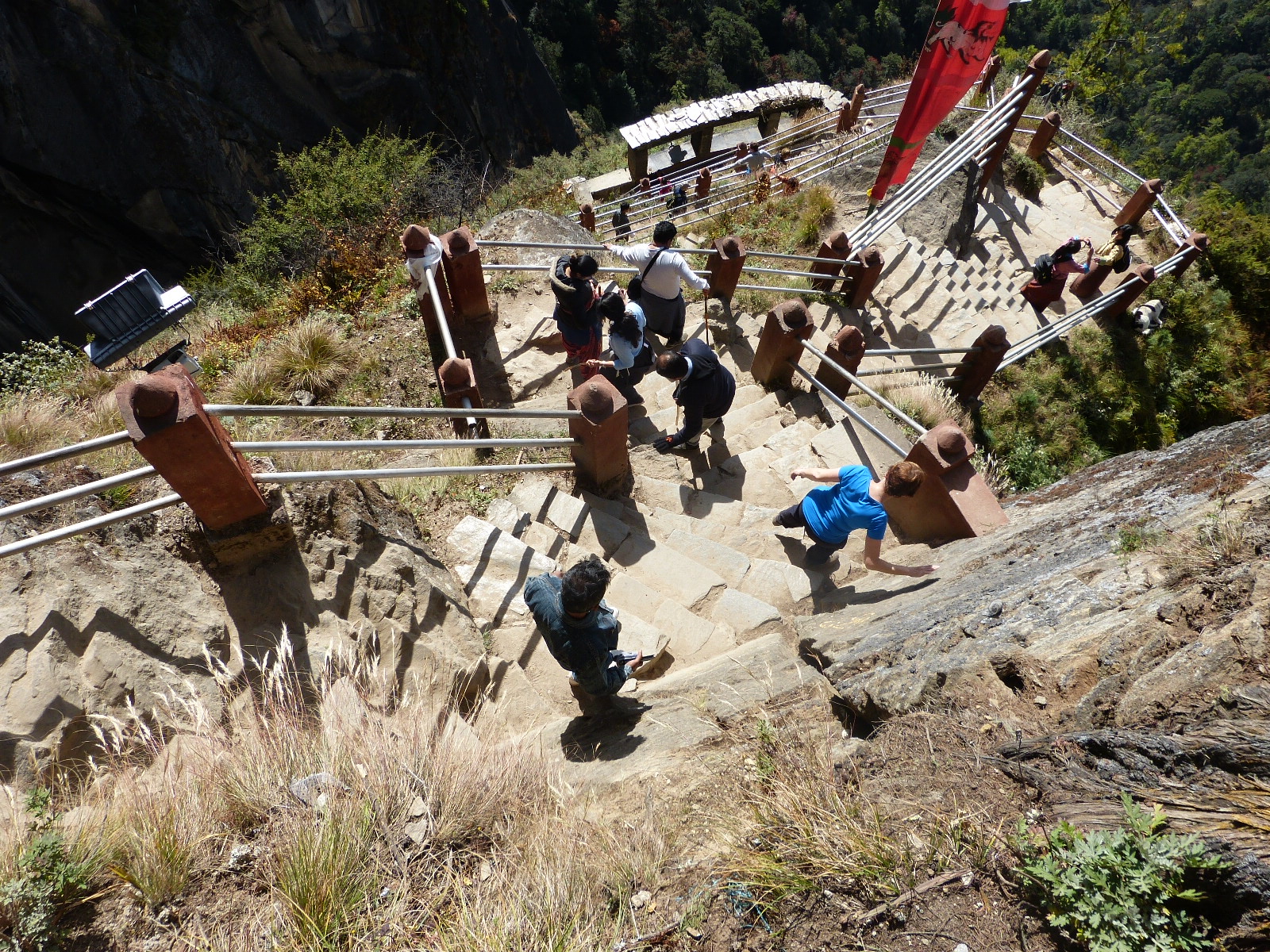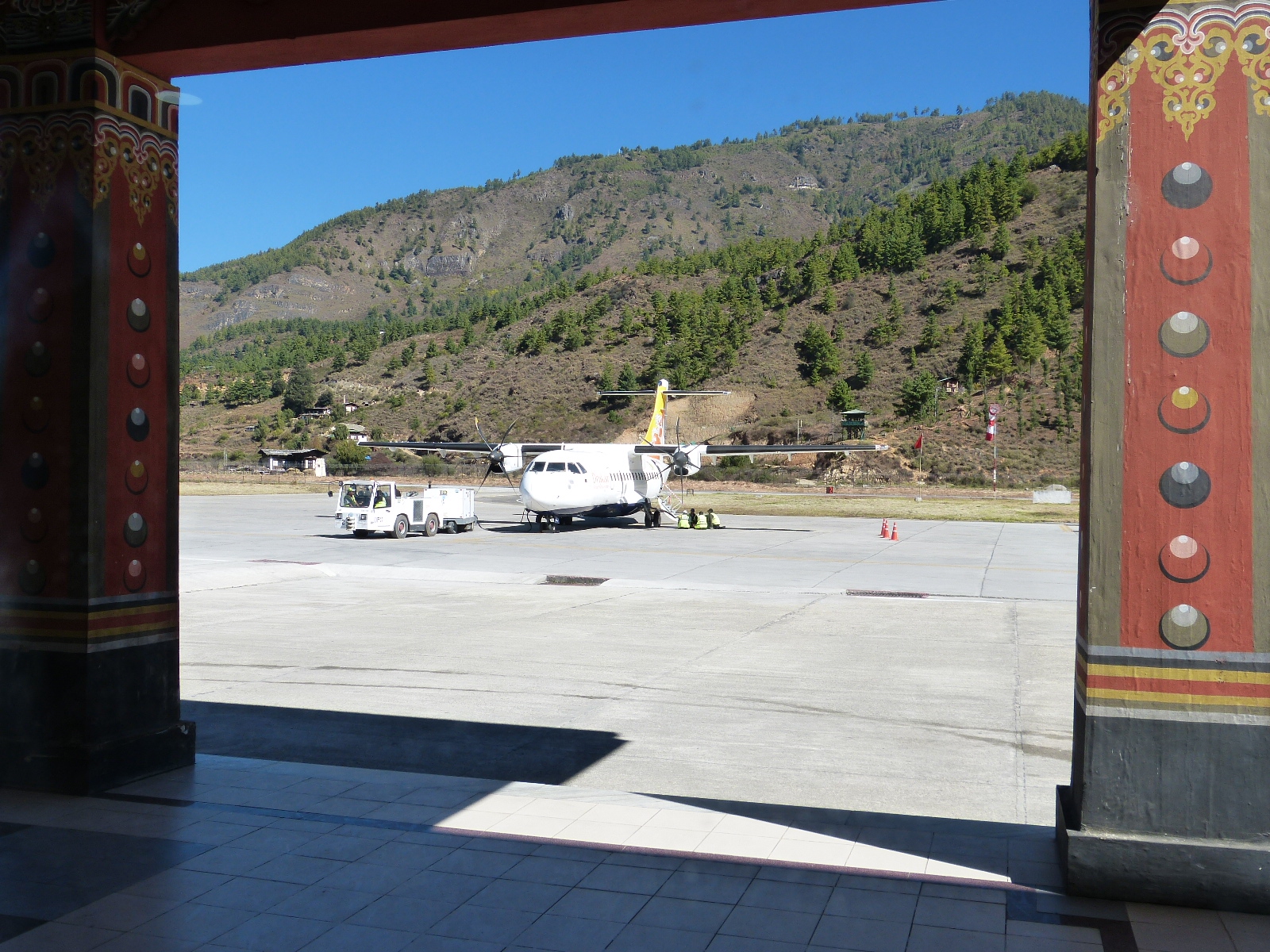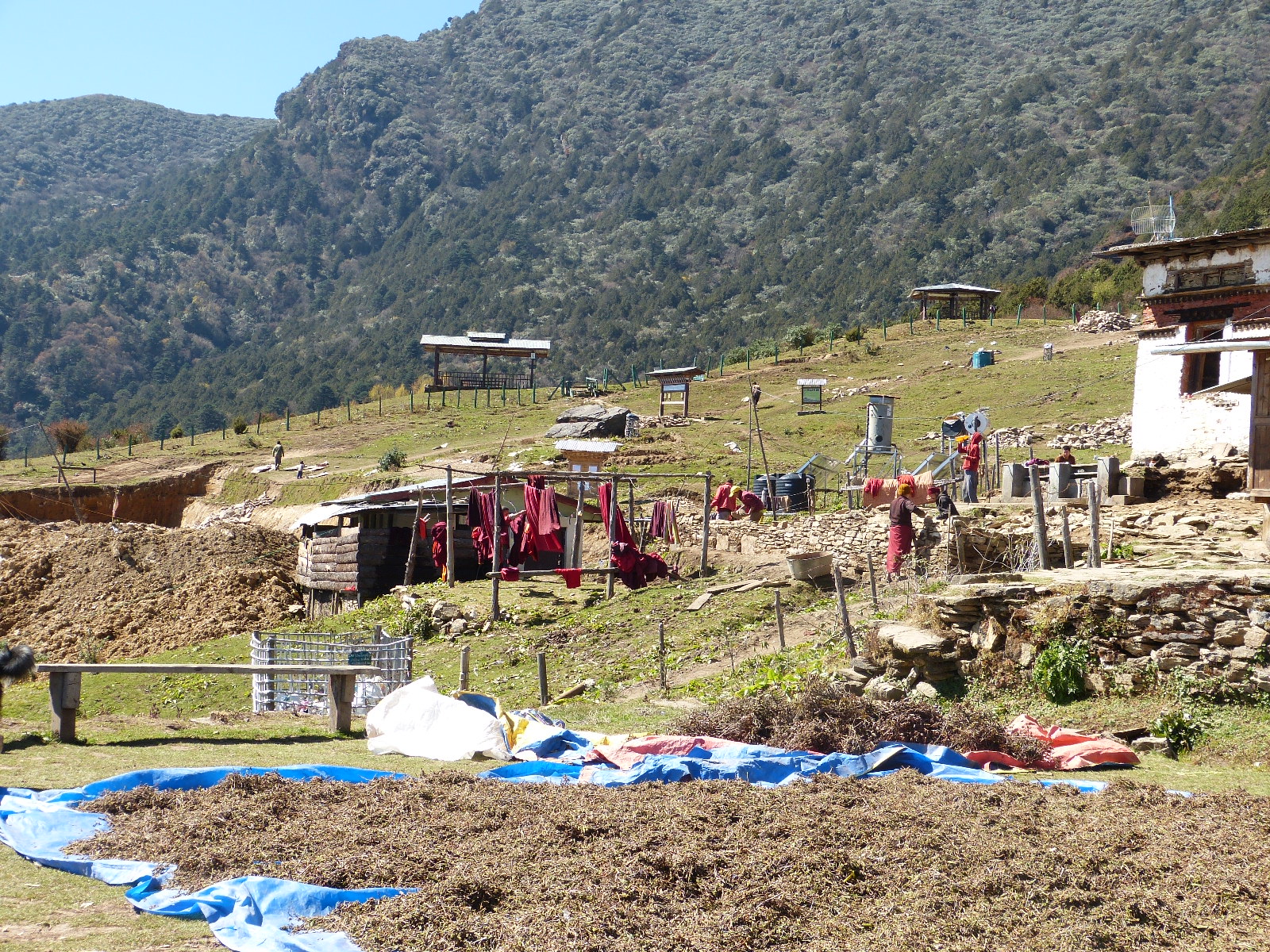Trekking in Bhutan
On the Monday morning after our free weekend in Thimpu, our delightful guide Tensin and our driver Dragbaar collected us and the very small bags of personal gear that we'd need for 6 nights in the mountains. About 30 minutes drive out of Thimpu we pulled into a layby where two men and lots of boxes, panniers were waiting for us and the packhorses. Dragbaar doesn't 'do' walking, so he left us in the safe hands on Ten and Mr Lobsang - a small, sturdy man with a ready smile and a big, old fashioned canvas knapsack, which turned out to be a bit of a magic bag! He was very much in charge, but in a quiet and confident unassuming sort of way. He later turned out to be part mountain goat when descending tracks at speed!
The horses were loaded up and we set off...straight up the mountainside. It was an easy and well used path as it led up up to a Monastery. The path even had 4 'resting stations' with benches along the route, but we were walking well and only needed to stop at two of them.


Once we'd reached the monastery, which took about two hours, we rested on a low wall looking at the stunning views. The monks were clearly doing a lot of work on the land around the monastery - bringing in a harvest of some sort of grain, doing their laundry and building dry stone walls but they also surprised us with cups of hot, sweet tea - perfect after a long climb! They're clearly used to trekkers!
Pause for thought!

There had been some sort of problem with one of the horses so, initially, Ten said we'd camp at the monastery for the night instead of at the usual campsite by a lake higher up the mountain. This concerned me a bit because it was a long pull up from the monastery to the summit and we'd got a 15 km walk, measured from that campsite, the following day.
It was decided that we'd do a little walk up to the south of the monastery for lunch so that we'd at least been up higher than we'd sleep. It was a fairly easy 40 minute walk before Mr Lobsang stopped us by some prayer flags which had a incredible view of the mountains, Thimpu in the valley bottom and the red roof of the monastery just visible - in the bottom right hand corner of the photo. Then from his knapsack he produced a large thermos which contained a 5 stack tiffin tin full of food then tea, coffee, plates, cutlery and cups - it really was a magic bag! There were 2 tins of boiled rice, then vegetables, cheese and hard boiled eggs....plus apples and bananas for pudding! Walking at altitude certainly makes us hungry.
The view from our picnic spot.
Lunch.
After lunch Ten announced that the horse problem had been sorted and the the camp was now set up just below the ridge. If you look back at the picnic spot photo you can see 3 blue tents on the grassy plateau. Not your average campsite as the only facilities were what the horses could carry but we've wild camped for long enough to be very used to this and we still see electric hookups as a bit of a treat! It wasn't the campsite we should have been at, but at least we didn't have to start from right back down at the monastery the following morning!
The tents were a large ridge tent for us to sleep in, a food tent with table and chairs for us and a mess tent for Ten, Mr Lobsang, "Boy" who did all the odd jobs and helped with the food preparation (and who we never heard called anything but "Boy") plus the man in charge of the horses. There was also the luxury of a toilet tent! Posh camping!
They had seen us descending so had cups of tea and bowls of hot water for us to wash in when we got to the camp. It cools down very quickly at that altitude, so it's important to do the washing and changing into thermal layers, down jackets, hats etc as quickly as possible once you've stopped for the day. They'd laid our our sleeping tent with insulated inflatable mats, sleeping bags, fleece liners, blankets and, joy of joys......hot water bottles when we went to bed!
I think it's fair to say that Bhutanese maps aren't really up to the high standards of Ordnance Survey maps that we're used to in the UK. At least Ten and Mr Lobsang knew the way!
Up, breakfasted and off by 08.00 the following morning - and it was a grueling day which started with a very steep ascent to the summit that made my legs wobble! It took us 3 hours to get to the lake where we should have camped and involved a lot of altitude changes with all the upping and downing, so I was incredibly grateful that we'd not had to start from right back at the monastery and that I'd heeded the advice to use trekking poles. The views were magnificent though - I'm always happy when I can see snow-capped mountains!
In the photo below you can see the track winding along just below the ridge behind us. A lot of the track was grotty, loose and slippery rocks, very much like Snowdonia only much, much bigger!

The horses, "Boy" and the horseman passed us as we reached the pass below the summit.

The Pass was at 4220 m or 13,845 feet

Snow-capped mountains everywhere!
From the summit it was a long, long contouring walk round a mountain on the path that wound it's way through rhododendron forests and over rocks before a slow descent to one of the most stunning lakes I've ever seen - and it was completely surrounded by steep mountains.
It had taken 7&1/2 hours to do 20 kms and we were shattered...but what a place to camp! It turned out that we should have been camping at the other end of the lake, where the smoke is coming from, but the Crown Prince of Bhutan and his retinue were camping there so we had a sweet little site by the stream instead.

Our evening meal was a very tasty and filling soup followed by rice, sardines, green beans, vegetables and cheese plus a delicious potato curry. We then had hit tinned fruit for pudding - which was surprisingly nice!

It was cold overnight and we slept in our thermals. It was bitterly cold, about -10, when we woke up so we had to put our clothes inside our sleeping bags to warm them up before we got dressed - it's a long time since I've had to do that! There was a heavy frost, but that's only to be expected at 3800m (12,470ft) in November I guess. At least the Prince's camp was equally chilly!

Looking out from our tent at Andy.
Staying in our tent drinking tea and doing the all important job of warming my clothes up!

Whilst we were pottering around after breakfast getting organised for our walk two of the Prince's bodyguards turned up. Apparently they'd already been to the camp first thing to check out who we were and what we were doing. They had a rapid conversation in Dzonkha with Ten with one English phrase of "once in a lifetime". Turned out that the Prince wanted to invite us to go for a row on the lake in one of his 2 boats to make up for the inconvenience of camping at the wrong end of the lake. This is a holy lake and it's the first time ever anyone other than the royal family have been allowed to go on it. Obviously we said yes!
Andy, Ten and I were kitted out in life jackets then, along with three soldiers, we paddled a circuit of the lake, took loads of photos, waved at our bewildered and astonished crew and rowed back to get out below the Prince's camp. The only thing that would have topped it would to have met the Prince himself, but we had to settle for asking the highest ranked soldier to give our profound thanks to the Prince instead. Ten was beside himself. He was literally in shock. The Bhutanese royal family are revered by the people. Things like this just don't happen - until they do! Our normally chatty guide was speechless for about half an hour whilst the rest of the crew couldn't stop talking about it!

Ten in total shock on the boat!

Once back at the camp we discovered a problem - the pack horses had disappeared overnight because the horse man hadn't tied them up. He had one job!!!
After some discussion amongst Ten, Mr Lobsang and "Boy" (the horse man had gone looking for the horses!) it was decided that we'd do the first part of today's walk and, depending on what happened with the horses, we'd either carry on to tonight's camp or come back to the lake camp.
I'd woken up with a snotty nose and a sinus headache which even a paddle on the lake couldn't shift, so my breathing was heavy and laborious as we climbed slowly and steadily up out of the valley. We sat looking at the view whilst they walked off to try to get a phone signal.
Looking back down to the lake.
We were eventually called to join them on the ridge for our picnic lunch - rice with paneer and peas, mushrooms and cheese and a potato and vegetable mix followed by grapes. All washed down with tea.

It was a phenomenal place to have a picnic - the lake way below us on one side, Paro in the valley below us on the other and totally surrounded by high mountains. it was stunning in a way that photos just can't capture.
It had been decided in the phone calls that the safest thing to do was to go back down to the campsite at the lake. Ten set off like a rocket down to the camp to make sure that everything was still there - he didn't trust the horse man not to have gone back with the horses, packed everything up and to have set off to the next camp, which would have been disastrous as there wasn't enough daylight time to walk to the next camp ..... and we'd have had to blag a bed from the Prince!
The Bhutanese are very factual when it comes to naming their birds. This translated as 'yellow beaked bird with long tail'

Once back down at camp we washed and changed into our thermals and were having a cup of tea and some popcorn when three of the Prince's soldiers walked past with fishing rods on their way to survey the lake to see if it's going to be good enough for tourists to fish there. When the soldiers came back, being me, being from Yorkshire and being nosy, I casually asked if they'd caught anything - as you do! The oldest soldier said "no" but then stopped to talk with me. He was very well spoken with excellent and almost accent-free English. he had an air of authority about him and was clearly used to organising things. He told me that the Prince was a keen sportsman and was looking at setting up a triathlon in Bhutan - which would involve swimming in the lake! Brrrrr!
Andy joined us and we discussed sustainability, rural depopulation and many other things. The Prince is currently touring rural populations to find out what the people need to help them develop more skills and stay in the countryside - hence the camping. So we told him about WOOF - the World Organisation of Organic Farmers, which might be useful for the Prince's aims. The man was very interested in that.
After he'd gone, Ten and the crew came out of the Mess tent where they'd been hiding. It turned out we'd just spent over half an hour chatting and laughing with the Prince's Aide-de-Camp and they were in awe of us being able to do that so freely and beside themselves to have seen that as well as the trip on the lake this morning. I'll talk to anyone, me!
As it was so cold again we were invited to sit by the open fire in the Mess tent to have our meal. The tent was lit by the fire, a single candle and a rather useless little battery lamp that gave out less light than our head torches! They brought chairs in from the meal tent for me, Andy and Mr Lobsang , whilst Ten sat on a rolled up mat and Boy and the horse man sat directly on the ground seems it was all about status. We gathered that they all slept on the floor in there too.
They all seemed very comfortable with us being in there and we were chatting away when the crew - who were facing the door, went silent. The Prince's bodyguard and a soldier had appeared in the doorway carrying a bucket! They had brought us 4 big rainbow trout as a gift from the Prince - they were so fresh that they were still flapping! It was obvious that Boy didn't know what to do with them (and I didn't want to him to lose face by offering to do it for him!) so the soldier dealt with the fish outside. The bodyguard accepted Mr Lobsang's chair and sat chatting and laughing with us for about half an hour or so before taking his leave. Ten and the crew were in awe again, but Ten did manage to answer some trek-related questions from the bodyguard. After they'd gone, nobody - including us, could quite believe it. What a surreal day!
After yesterday's debacle with the horses and us having to stay two nights in the same camp, it was decided that we'd have to do 1&1/2 days' distance today - 17 kms and a similar distance again tomorrow to make up for the distance we should have done yesterday. Ten announced that, as we'd already been up onto the ridge yesterday, instead of repeating that then walking along the length of the ridge to tonight's camp, we'd do the (supposedly) easier and lower horse track.
Andy, Ten and I set off following the river steeply down - very tough on my knees even with my trekking poles! I had to really concentrate on the track as I am somewhat prone to accidents and an accident in that isolated valley would have been a nightmare to sort out!
Just before we reached the valley floor, Mr Lobsang and Boy came bounding down the track at high speed, bouncing from rock to rock but barely touching them - is was so impressive compared to our cautious descent. They really were mountain goats in human form!
Mr Lobsang on the bridge!

With Mr Lobsang in his usual position at the back and providing snacks and encouragement when necessary,we set off up a very steep and grueling ascent. The pack horses had created 'steps'...except that the tread of each step was hollowed out by their hooves. I found the height of the risers and the depth of the hollowed out treads an incredibly difficult combination for my short legs, but Andy, being a foot taller than me, barely noticed. After multiple ascents and descents, it was a massive relief to get up onto the ridge and be able to rest for a while and have a snack from Mr Lobsang's magic knapsack!
Being up on the ridge was lovely and at least the ups and the downs were nowhere near as steep or deep as previously - especially as all the 'downing' had really begun to affect my left knee. It was fine on 'alongings' and most of the 'uppings', but the 'downings'....ouch!
We walked past a nomad camp, which I thought was the campsite we should have been at last night. Then we eventually walked through another area which had quite a few tents and a lot of rubbish - we thought this was our campsite for the night because both Andy and I reckoned we should have reached it by now. Not far beyond that campsite we stopped for lunch....once Ten had chased a couple of yaks away!
Lunch was the fish from the Prince....although I don't think they had fresh fish very often as it had been just chopped into chunks! It was absolutely delicious though!

Ten was very vague about how far we still had to go, so we plodded on expecting to see the campsite at any time. The track was very clear and well used. It was sandy, stony and covered in roots in some places and lovely open grassland in other, but always the mountains around us.
Eventually we were becoming concerned because time was marching on and we needed to get to the camp before dark as we didn't have our head torches with us. Andy asked Ten directly where the campsite was. Ten admitted we were well past where we should have camped and heading towards the original final night camp.....because the horse man (him again!!) had disobeyed Ten and Mr Lobsang's instructions about where to camp and independently decided to continue on! We were not impressed.
Andy and Ten had a difficult conversation because Andy felt we'd been lied to all day. Ten agreed he should have told us what the horse man had done as we passed the campsite, but he was worried about our reactions. We were actually more cross about him not telling us than we were about having to do 2 days walk in one although I was really starting to struggle with my knee, which was badly swollen by this point. Ten told me I was amazing for keeping going. I pointed out that I didn't really have any choice as I had no intention of sleeping out on the mountain with the yaks! There wasn't much he could say to that.
Ten then pointed out the Jela Dzong Temple in the distance and told us the campsite was 10 minutes before the temple. It turned out to be about 10 minutes after the temple and down a steep track. I have never been so glad to see our tents and sit down! We'd done a tough 25 kms instead of 17. The horse man was conspicuous by his absence all evening. Ten said that the horse man had decided that the planned camp wasn't good enough, there wasn't sufficient water and he knew we could do the extra distance - such faith! We suspected he actually just wanted to finish by lunchtime as they normally did.
It was an early start and they were packing up camp even as we were eating breakfast - aided by a random pony that wandered into our camp and got a guy line caught on his pack harness and pulled a tent down.
The start of the final descent off the mountains.

My knee was still swollen and sore, but not as bad as the previous night. We did a steady 5-6 km walk down a sandy, rooty track with some stony areas and a couple of slightly slippery stream walks. I was being VERY careful as I didn't want to jeopardise our walk up the The Tiger's Nest Monastry the following day. I was very happy to see Dragbaar and his car, especially as it was another 5 kms to the 'real' end of the road! Ten had phoned him to ask him to bring his car as far up the track as he could.
The goodbyes were a bit awkward. We were supposed to tip the crew, which we did...but we Brits are just not very good at tipping and find it excruciatingly embarrassing. Mr Lobsang, who had spoken hardly any English to us all week, insisted in English that the horse man was NOT to be given a tip as he had caused all the problems and I'd been injured as a result of his behaviour. We obeyed, but it did all feel like a slightly unsatisfactory end to a great trip and a mostly nice relationship with them.
Ten and Dragbaar took us back to Thimpu and left us at our hotel where, to our amazement, we were given the best suite in the hotel....and we had a wonderful night's sleep!






























































